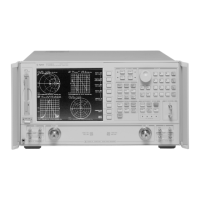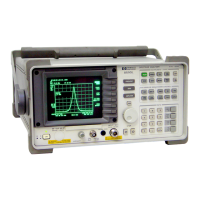6- 19
Calibrating for Increased Measurement Accuracy
Frequency Response and Isolation Error Corrections
NOTE You can save or store the measurement correction to use for later measurements. Refer to
Chapter 4 , “Printing, Plotting, and Saving Measurement Results” for procedures.
14. This completes the response and isolation correction for transmission measurements. You can connect
and measure your device under test.
Response and Isolation Error Correction for Reflection Measurements
The response and isolation error correction for reflection measurements provides the following benefits:
• removes frequency response of the test setup
• removes isolation in transmission measurements
• removes directivity in reflection measurements
To perform the response and isolation error correction for reflection measurements:
1. Press .
2. Select the type of measurement you want to make.
❏ If you want to make a reflection measurement on PORT 1 (in the forward direction, S
11
), leave the
instrument default setting.
❏ For ES analyzers, if you want to make a reflection measurement on PORT 2 (in the reverse direction,
S
22
), press:
3. Set any other measurement parameters that you want for the device measurement: power, sweep type,
number of points, IF bandwidth.
4. To access the measurement correction menus, press:
5. If your calibration kit is different than the kit specified under the softkey, press:
(select your type of kit)
If your type of calibration kit is not listed in the displayed menu, refer to "Modifying Calibration Kits" on
page 7-57.
6. To select a response and isolation correction and to start with the response portion of the calibration,
press:
7. Connect the short or open calibration standard to the port you selected for the test port (PORT 1 for S
11
or PORT 2 for S
22
on ES analyzers).
NOTE Include any adapters that you will have in the device measurement. That is, connect the
standard device to the particular connector where you will connect your device under test.

